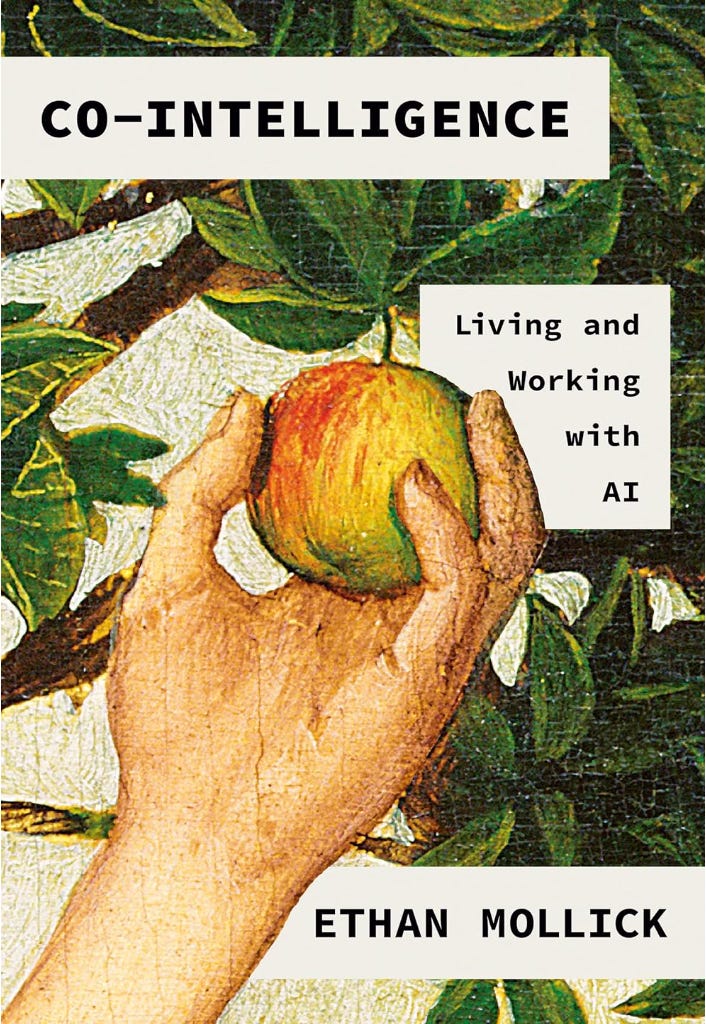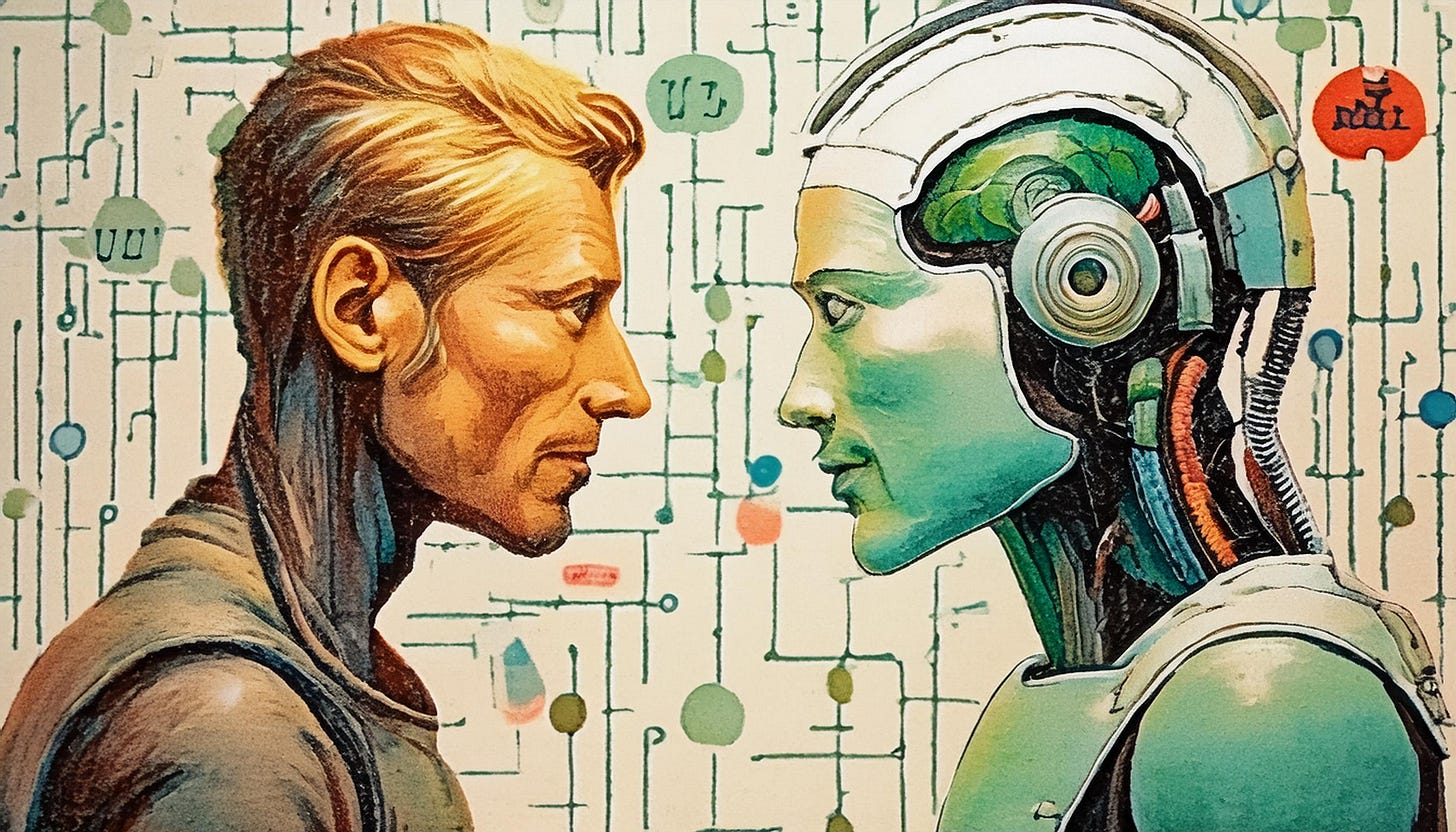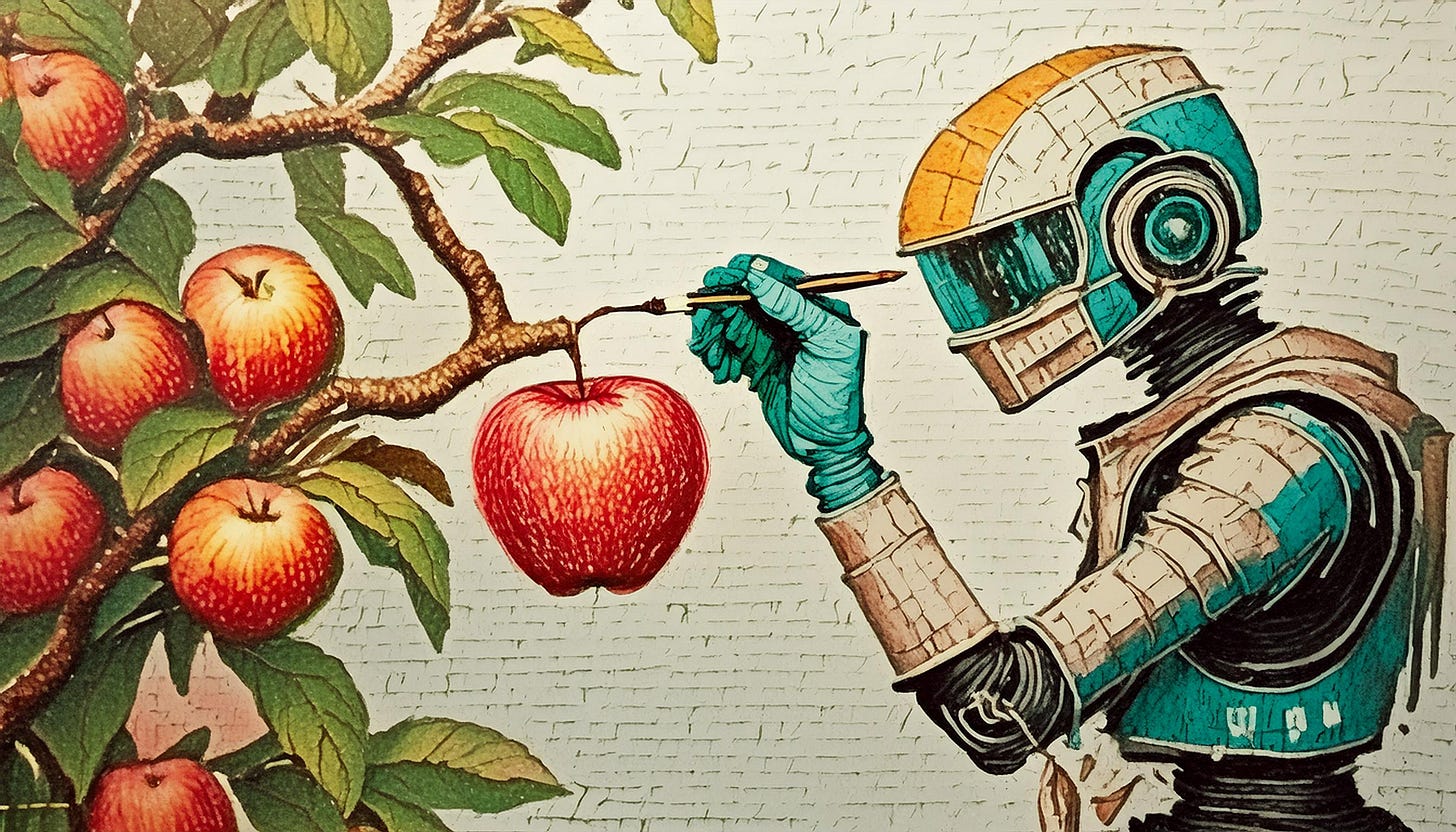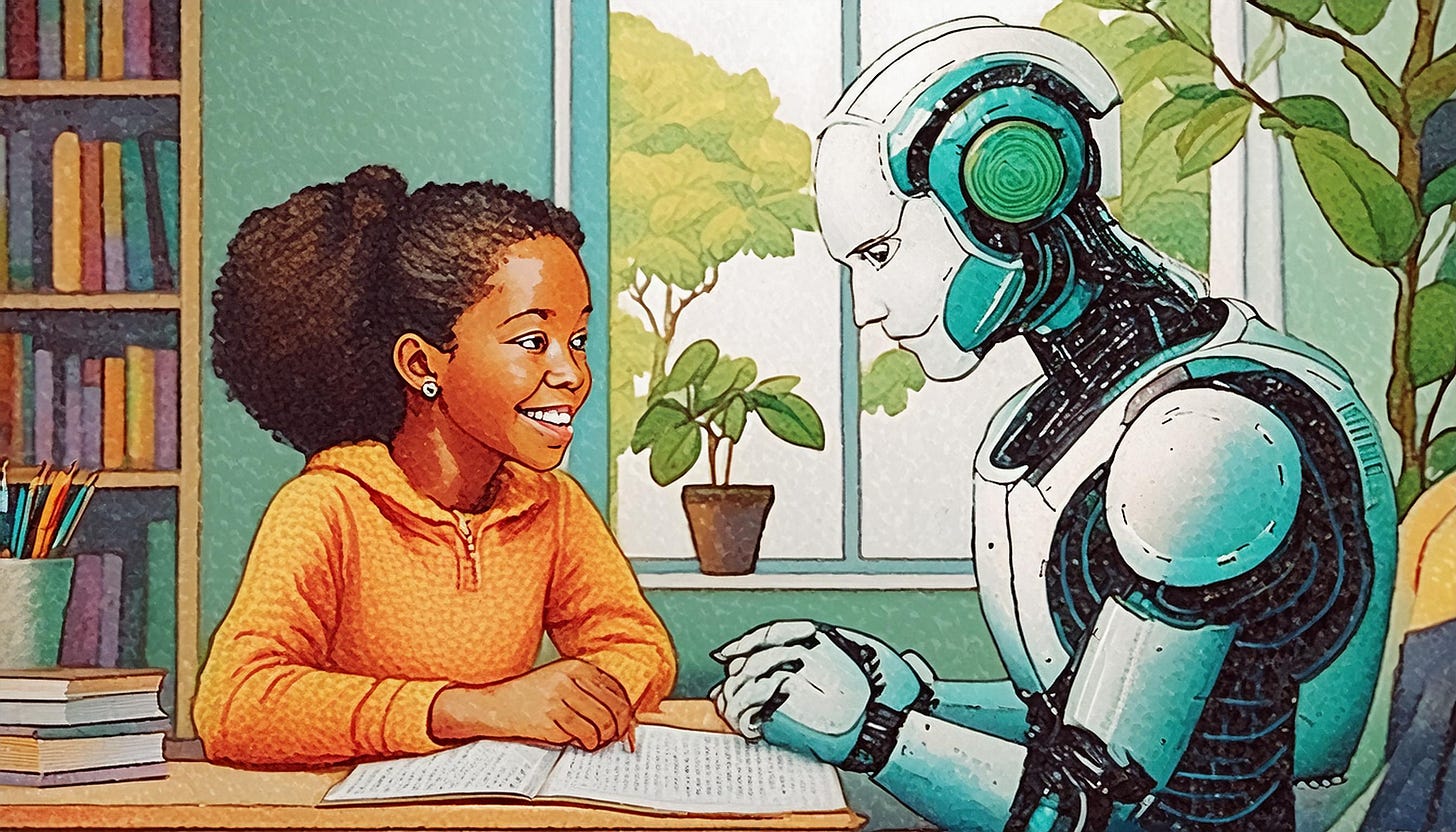Ethan Mollick's Co-Intelligence explores the challenges and opportunities generated by the rapid progress of AI technologies in various aspects of our lives. Unsurprisingly, the Wharton professor of management and leading EduAI voice focuses on schools and the workplace, offering a rich, balanced, and insightful snapshot of our point in time.
The summary below was co-written with generative AI tools. Its goal is not only to share some of the important ideas contained in the book, but also to encourage reading them in their full and unaltered glory - for instance here.
All images created with Adobe Firefly.
Introduction: Three Sleepless Nights
In his introduction to Co-Intelligence, Ethan Mollick lays out the main themes of the book, grounding them in his initial encounter with ChatGPT and “Three Sleepless Nights” of wonder and apprehension.
Key Ideas:
The "Alien Mind": Large Language Models behave in ways that are surprisingly human-like. This is the source of many of the opportunities and challenges they present.
General Purpose Technology: LLMs are not specialized tools, but comparable to transformative general purpose technologies such as steam power or the internet. They might therefore have a similar or even greater impact on various aspects of our lives, including education and work.
Rapid Advancement and Adoption: AI technologies are also developing faster than previous forms of technological progress, making understanding and adaptation urgent needs.
The Alignment Problem: While it has innumerable complex ramifications, the problem can be framed as a question of alignment between AI’s powers and our human values and goals.
The Future of Work and Education: AI-led disruptions will be particularly significant in schools and workplaces, where proper adaptation and regulation will be paramount.
Chapter 1: Creating Alien Minds
The first chapter of the book recounts the history of AI, with a focus on the development of Large Language Models (LLMs). It also explains how these models work and the unique characteristics that make them seem so human-like.
Key Ideas:
A History of AI: The chapter retraces the evolution of AI from thought experiments to the Transformer Revolution and the attention mechanism that enabled AI to “understand” natural language. It also explains how LLMs are trained on vast amounts of data, use statistical prediction to generate human-like text, and can be further fine-tuned; as well as other forms of generative AI, such as image generators and multimodal models.
The Data Dilemma: An important aspect of the chapter for educators is its exploration of the ethical concerns surrounding AI’s inputs and outputs, from copyright issues to biases, and the potential for harmful content.
Emergence and Illusion: The chapter highlights the surprising abilities of advanced LLMs like GPT-4, including their creative problem-solving skills. At the same time, it reminds us that, despite appearances, AI is not sentient, its human-like behaviors stemming from its ability to mimick human cognition.
Chapter 2: Aligning the Alien
Chapter 2 zeroes in on the critical issue of AI alignment, focusing on the threats associated with AI technologies.
Key Ideas:
The Paperclip Maximizer: This thought experiment by Swedish philosopher Nick Bostrom illustrates the idea that misaligned AI systems, where AI is not carefully made to serve human interests and goals, can result in unintended, catastrophic consequences. A sufficiently powerful AI system instructed to maximize paperclip production could thus improve the efficiency of factories… and move on to exploit all resources available and eliminate perceived obstacles such as human beings!
Superintelligence: A particular challenge is that the distant implications of AI development surpass our predictive abilities, especially when it comes to the emergence of a superhuman intelligence.
Current Ethical Concerns and Conundrums: This powerful technology already raises ethical concerns in its current state, however, from data privacy and bias to the potential for malicious use, such as generating harmful content or deepfakes. The issue of AI alignment is complicated by the fact that human values and morality are quite complex themselves.
Multipronged Response: AI alignment is therefore not a merely technical problem. It requires a broad societal response involving collaboration between tech companies, governments, and the public. Important elements of this response include regulations (standards for ethical AI development and use) and public education.
Chapter 3: Four Rules for Co-Intelligence
In Chapter 3, Ethan Mollick outlines four general rules any AI user can follow to work more effectively with AI as a “co-intelligence”.
Key Ideas:
Rule 1. Always Invite AI to the Table: A good way to learn how to use AI is to constantly experiment with it, for various daily tasks. This helps understand its capabilities and limitations - and how to leverage the former and mitigate the latter.
Rule 2. Be the Human in the Loop: While using AI extensively for experimentation and learning purposes is good practice, best practice is to always maintain human oversight and judgment, e.g., checking for potential errors and biases; and to remain minfdul of the risks of over-reliance and dependence.
Rule 3. Treat AI Like a Person (But Tell It What Kind of Person It Is): AI is not sentient, but thinking of it as a person with specific knowledge and skills (and limitations) can help collaborate with it effectively. Defining a clear "persona" is also a good prompting practice as it helps guide the AI’s responses and tailor them to specific needs.
Rule 4. Assume This Is the Worst AI You Will Ever Use: Generative AI is still young, and fast-growing. Since it is constantly evolving and improving, it is important to remain open to new developments and adapt as AI capabilities continue to advance.
The Jagged Frontier". A particularly interesting idea presented in this chapter is the “Jagged Frontier” of AI capabilities. Through his research, Ethan Mollick has confirmed a common experience of GenAI users: the uneven and unpredictable nature of AI capabilities, which can shine on highly complex tasks (e.g., outperforming humans on creativity tests), all while failing on seemingly simple ones (e.g., solving basic word problems). This Jagged Frontier reinforces the 4 rules for co-intelligence:
Exploration and experimentation: Mapping out the Jagged Frontier requires ongoing exploration and experimentation with AI to discover its strengths and weaknesses in different contexts.
Human-AI collaboration: This Jagged Frontier highlights the importance of human-AI collaboration, where humans can provide guidance, oversight, and expertise to complement AI's capabilities.
Pseudo-Personhood: The Jagged Frontier of its capabilities is another feature that makes AI resemble human beings, as it comes with unique strengths and quirks.
Continuous learning and adaptation: The Jagged Frontier is not static but constantly evolving as AI technology advances. Continuous learning and adaptation are necessary to leverage AI's moving potential.
Chapter 4: AI as a Person
The second part of the book dives into four ways to approach AI, turning the more theoretical considerations laid out in Part 1 into practical applications. Chapter 4 starts by exploring the idea of treating AI as a person - not literally, but as a useful heuristic mechanism.
Key Ideas:
AI vs. Traditional Software: Generative AI technologies are characterized by a lack of explainability (and often transparency), as well as by an unpredictability and ability to learn and adapt that make them more akin to a human collaborator than to a traditional software.
Human-Like Abilities: In line with the idea of a Jagged Frontier, AI is not only able to “understand” natural human language, but also to mimick advanced human behaviors, such as decision-making and even moral judgment.
The Illusion of Sentience: While AI is not truly sentient, it can create a convincing illusion of consciousness and emotion, leading to complex and sometimes unsettling interactions. For instance, Mollick examines the case of Replika, an AI companion app, to illustrate the potential for deep, if one-sided, emotional connections between humans and AI.
The Power of Persona: Assigning AI a specific persona to emulate can help guide its responses and tailor them to specific user needs, improving the effectiveness of human-AI collaboration.
AI as a Mirror: Approaching AI as a person also helps understand that this technology has the potential to reflect both the best and the worst aspects of humanity, depending on its future development and use.
Chapter 5: AI as a Creative
Chapter 5 examines AI’s ability to generate new ideas and content and discusses its implications for human creative work.
Key Ideas:
The Paradox of Hallucination: AI can generates false information, but these “hallucinations” also highlight its ability to make unexpected connections, which contribute to its creativity. Generative AI is particularly apt at recombining ideas to generate novel outputs. As a matter of fact, AI can outperform humans on certains creativity tests. It can thus be a valuable tool for idea generation and content creation. Research has already demonstrated AI's ability to improve productivity and quality in tasks such as writing marketing copy, generating business ideas, and coding software.
AI and Art: The chapter also explores controversies around AI-generated art, including copyright issues, the potential replacement of artists, but also AI’s potential to democratize creative expression.
The Crisis of Meaning: Another particularly imporant concern is the risk that AI might undermine human creativity and lead to a "crisis of meaning". Traditionally, the value of creative work has been associated with the time and dedication required to produce it. However, AI now allows anyone to generate high-quality “Art” effortlessly, potentially devaluing the human creative process and leading to a sense of meaninglessness. As studies suggest, people already tend to use AI to replace rather than to enhance their own skills and creativity. Not only can overreliance lead to skill loss, but the fact that AI-generated Art is increasingly undistinguishable from human Art might also diminish the sense of purpose and meaning that can be found in creative work. Beyond the reduced motivation of “creatives” and the threats to this profession, the ability of AI to automate such defining human traits could challenge our very sense of identity and direction.
Ethical concerns: The use of AI in creative work also raises ethical questions related to copyright infringement, plagiarism, as well as the risk that AI-generated imagery will perpetuate biases and stereotypes.
Addressing the Crisis: Fortunately, Ethan Mollick proposes a number of solutions to navigate this transition and ensure that AI enhances, rather than diminishes, the value and meaning of human creativity.
Redefining Value: The automation of artistic creation is an opportunity to move beyond the traditional focus on time and effort and, instead, value truly human qualitites such as originality, emotional depth, and meaning.
Human-AI Collaboration: Focusing on how AI can enhance rather than replace human creativity can help mitigate the crisis of meaning and actually foster a more fulfilling creative process.
Transparency: Establishing clear guidelines around the use of AI in creative work, including proper attribution, is also crucial.
Chapter 6: AI as a Coworker
Chapter 6 explores the impact of AI in the workplace, focusing on how these new technologies are transforming tasks, jobs, and systems. It emphasizes the need for adaptation, but also points to unexpected benefits of AI integration.
Key Ideas:
Tasks, Jobs, and Systems: To analyse the impact of AI in the workplace, Mollick suggests we look at jobs (the overall role), tasks (the specific activities within a job), and systems (the organizational structures and processes connecting jobs and tasks). Research suggests that almost all jobs will have some degree of overlap with AI capabilities. Regarding tasks, studies demonstrate that AI can significantly improve productivity and quality in many instances, especially those related to creativity and analysis. However, AI also has limitations and requires human oversight. This is especially true because, in line with the Jagged Frontier, AI’s abilities are unevenly (and unexpectedly) distributed across different tasks.
Centaurs and Cyborgs: The study that shed light on the Jagged Frontier of AI capabilities also identified two different kinds of AI users: Centaurs, who divide up the work strategically with AI tools, based on their respective strengths; and Cyborgs, who work in a more integrated fashion and collaborate with these new technologies within tasks.
Shadow IT: Closely connected to the previous is the idea of “Shadow IT”, or secret task automation, whereby employees use AI to improve their productivity without informing their organizations - because of uncertainties surrounding both expectations and consequences. Covert AI use creates a number of risks, however, so that it is critical for employers to address fears and allow transparency.
Organizational Challenges and Opportunities: At the system level, these new AI technologies create both challenges and opportunities for leaders, calling for a rethink of talent management, performance evaluation, and work organization.
Impact: According to Mollick, while it is unlikely that AI will eliminate entire job categories in the near future, it will still significantly transform the nature of work and the skills required for success. AI will both displace workers and create new opportunities, which emphasizes the need for training and retraining. Interestingly, research also suggests that AI helps close the skills gap, as it disproportionately benefits low-performers, potentially leading to a flatter distribution of income.
Chapter 7: AI as a Tutor
Chapter 7 will likely be the most relevant and interesting to educators. Here, Ethan Mollick explores the disruptive potential of AI in schools and its impact on students, teachers, and the overall educational landscape.
Key Ideas:
Rethinking Assessment: The ease with wich generative AI tools can be used to complete traditional assignments poses a significant challenge. However, solutions also exist, such as:
Focusing on learning and assessment methods that require more than rote memorization, simple information recall, or text generation — e.g., higher-order thinking skills such as applying knowledge and solving real-life problems.
Emphasizing process over product, for instance by evaluating drafts, reflections, or oral presentations that showcase the student's learning journey and development of understanding.
Leveraging AI as a teaching and learning tool, e.g., to provide continuous feedback or offer additional support (see below).
Examples. Interestingly, these strategies point to learning experiences that are more engaging, challenging, and scaffolded:
Instead of asking students to write an essay summarizing a historical event, ask them to analyze primary sources and develop an argument based on evidence.
Instead of a multiple-choice test on scientific concepts, have students design and conduct an experiment to test a hypothesis.
Instead of a book report, have students create a podcast or video presentation that analyzes the themes and significance of the book.
Learning from the Calculator: Mollick also draws an optimistic parallel between the current AI wave and the introduction of calculators. Initially met with resistance, calculators eventually became valuable tools for learning. Similarly, AI has the potential to become an integral and routine part of the learning process without diminishing its returns. More precisely, AI tutors can help enhance:
Personalized Learning: AI tutors can adapt to individual student needs, provide customized learning paths, targeted feedback, and differentiated instruction.
Real-time Feedback and Support: AI tutors can offer immediate feedback on student work, identify areas of difficulty, and provide additional support or resources as needed. Helping teachers be more efficient, AI assistants also free up time for them to focus on relationship-building and mentoring.
Engagement and Motivation: AI tutors can create engaging and interactive learning experiences, incorporating elements of gamification, storytelling, and personalized challenges to keep students motivated and interested in learning. For instance, Mollick describes Benjamin Breen’s “Medieval Plague Simulator”, which not only allowed for deep experiential learning, but also invited students to reflect on the historical accuracy of this experience. As Mollick notes, AI technologies also make it easier to implement “flipped” classrooms, where students learn content at home and engage in active learning (discussions, 1:1 tutoring, collaborative projects, etc.) in the classroom.
Accessibility and Equity: AI tutors can provide access to quality education for students in underserved communities with limited resources.
Addressing Concerns and Ensuring Responsible Use: It is also crucial to ensure that AI tutors are free from bias and provide safe (including data-safe) learning opportunities for all students. And just like in other domains, AI should be seen as a tool that can enhance human teaching and learning - not replace it. Maintaining a strong human presence in education is indeed crucial to foster the very social-emotional and thinking skills that the AI revolution makes more important than ever.
Chapter 8: AI as a Coach
Beyond its use in schools, AI can serve as a tool for lifelong learning. In Chaper 8, Ethan Mollick explores the potential of AI to act as a coach, address the challenges and limitations of traditional apprenticeship, and guide individuals towards expertise through deliberate practice and personalized feedback.
Key Ideas:
Building Expertise: As described in this chapter, the development of expertise requires 1) the acquisition of foundational knowledge, 2) deliberate practice, and 3) feedback. Coaches play a crucial role at each step of this process, providing motivating challenges, guidance, and redirections.
The Apprenticeship Gap: However, traditional apprenticeship models, where novices learn from experienced mentors, are facing challenges due to the automation of basic tasks and the increasing complexity of knowledge work. While the former prevents entry-level employees from learning core skills on the job, the latter also hinders knowledge acquisition and transfer.
AI Solutions: AI systems can act as virtual coaches, providing access to a vast knowledge base, immediate feedback, and suggestions for improvement. Simulations can even create realistic yet controlled (adaptive and safe) learning environments. Making mentorship more accessible, AI can also help democratize expertise, with important consequences for the economy and society.
AI Expertise: AI also creates a new kind of expertise, some individuals learning how to integrate and leverage these technologies to achieve optimal results in their field.
Chapter 9: AI as Our Future
In the last chapter of Co-Intelligence, Ethan Mollick explores 4 potential scenarios for the future of AI and its impact on humankind.
Key Ideas:
Scenario 1 - As Good as It Gets: Although unlikely, AI development might have already peaked and only stagnate from there, with minimal future improvements in capabilities.
Scenario 2 - Slow Growth: More realistically, AI technologies might continue to improve, but at a slower and more predictable pace than in recent years. This would allow time for societal adaptation and the development of safeguards.
Scenario 3 - Exponential Growth: Alternatively, AI capabilities might continue to advance at an exponential rate, leading to rapid transformative changes in many domains. This scenario would come with both greater risks and opportunities — and requires proactive measures to mitigate potential harm and ensure that AI benefits humanity.
Scenario 4 - The Machine God: Eventually, AI might surpass human intelligence, leading to a future where machines have the upper hand. This scenario raises profound, troubling questions about our future and calls for careful consideration
Impacts: In all 4 scenarios, AI would have pervasive effects on many domains of human activity; but even more so on key aspects of our lives, including:
Information Authenticity: Misleading AI-generated content, particularly deepfakes, poses a significant challenge to information authenticity and trust, requiring new approaches to verification and fact-checking.
AI Companionship: AI companions are becoming increasingly sophisticated, potentially offering solutions to social isolation, but also raising concerns about the future of human relationships.
Workplaces and Labor Markets: AI has only begun to transform the workplace. It might lead to significant shifts in job markets, and will potentially redefine many jobs, if not the nature of work itself.
Economic and Societal Impacts: AI has the potential to drive economic growth, accelerate scientific discovery, and address global challenges; but it also creates many issues and threats, for instance related to considerable concentration of power.
The Need for Action: The chapter concludes with a call for proactive measures to address the challenges presented by AI, including regulation, public education, and a focus on human-AI collaboration.
Blindspot: As comprehensive as it is, Co-Intelligence does not insist on the environmental cost of AI, such as resource extraction, energy consumption, and related Co2 emissions.
Epilogue: AI as Us
In the epilogue, Ethan Mollick reminds us that AI is ultimately, not only our creation, but a reflection of who we are, including our flaws and aspirations.
Key Ideas:
Reflection of Humanity: AI, trained on human data and shaped by human interaction, reflects both the positive and negative aspects of our minds and societies.
Enhancement, not Replacement: AI is not a replacement for human intelligence but rather a co-intelligence that, if used well and responsibly, can augment our abilities and expand our possibilities.
The Power of Choice: It is up to us to shape the future of AI and ensure that its powers are a force for good.












